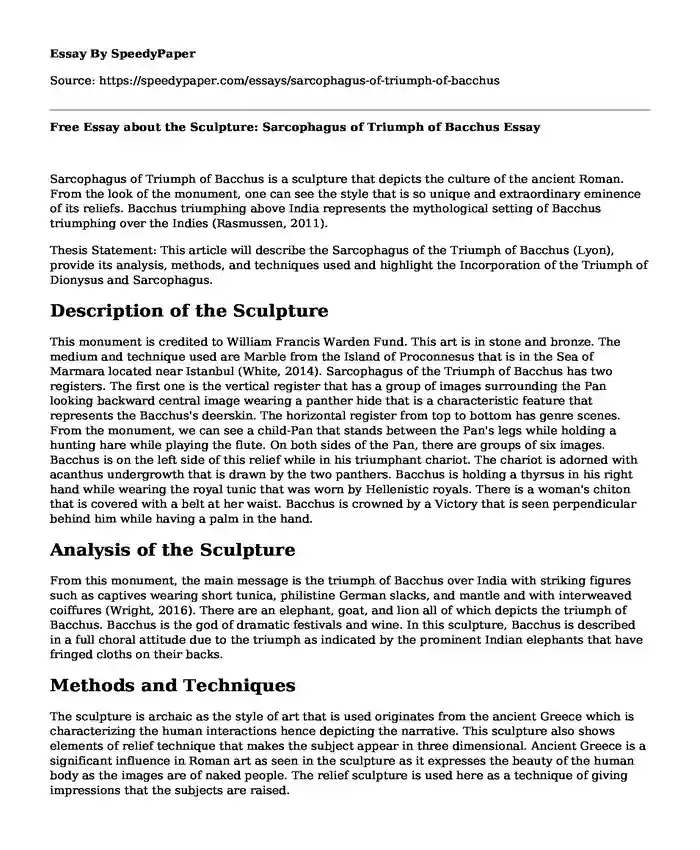Sarcophagus of Triumph of Bacchus is a sculpture that depicts the culture of the ancient Roman. From the look of the monument, one can see the style that is so unique and extraordinary eminence of its reliefs. Bacchus triumphing above India represents the mythological setting of Bacchus triumphing over the Indies (Rasmussen, 2011).
Thesis Statement: This article will describe the Sarcophagus of the Triumph of Bacchus (Lyon), provide its analysis, methods, and techniques used and highlight the Incorporation of the Triumph of Dionysus and Sarcophagus.
Description of the Sculpture
This monument is credited to William Francis Warden Fund. This art is in stone and bronze. The medium and technique used are Marble from the Island of Proconnesus that is in the Sea of Marmara located near Istanbul (White, 2014). Sarcophagus of the Triumph of Bacchus has two registers. The first one is the vertical register that has a group of images surrounding the Pan looking backward central image wearing a panther hide that is a characteristic feature that represents the Bacchus's deerskin. The horizontal register from top to bottom has genre scenes. From the monument, we can see a child-Pan that stands between the Pan's legs while holding a hunting hare while playing the flute. On both sides of the Pan, there are groups of six images. Bacchus is on the left side of this relief while in his triumphant chariot. The chariot is adorned with acanthus undergrowth that is drawn by the two panthers. Bacchus is holding a thyrsus in his right hand while wearing the royal tunic that was worn by Hellenistic royals. There is a woman's chiton that is covered with a belt at her waist. Bacchus is crowned by a Victory that is seen perpendicular behind him while having a palm in the hand.
Analysis of the Sculpture
From this monument, the main message is the triumph of Bacchus over India with striking figures such as captives wearing short tunica, philistine German slacks, and mantle and with interweaved coiffures (Wright, 2016). There are an elephant, goat, and lion all of which depicts the triumph of Bacchus. Bacchus is the god of dramatic festivals and wine. In this sculpture, Bacchus is described in a full choral attitude due to the triumph as indicated by the prominent Indian elephants that have fringed cloths on their backs.
Methods and Techniques
The sculpture is archaic as the style of art that is used originates from the ancient Greece which is characterizing the human interactions hence depicting the narrative. This sculpture also shows elements of relief technique that makes the subject appear in three dimensional. Ancient Greece is a significant influence in Roman art as seen in the sculpture as it expresses the beauty of the human body as the images are of naked people. The relief sculpture is used here as a technique of giving impressions that the subjects are raised.
Incorporation of the Triumph of Dionysus and Sarcophagus
These sculptures are sarcophagus and have archaic art elements since they depict a story. This is because most of the arts of the ancient Roman incorporated most of their gods and goddesses as they were a polytheistic society. The relief sculpture described above brings out the emotions as well as the other hidden details of the statue. The monument shows the beauty of the human body that is a concept adopted from the Ancient Greek society.
References
Rasmussen, T. (2011). Bacchus Triumphs on the North Downs: the Polesden Lacey Sarcophagi. Bar International Series, 940, 335-342.
White, F. (2014). Marble Provenance Investigation of the Roman Sabine Sarcophagus. Retrieved from; https://www.researchgate.net/publication/273309624_Marble_provenance_investigation_of_the_Roman_Sabine_sarcophagus
Wright, D. H. (2016). 4.4. A Tetrarchic Frieze. The Collection of Antiquities of the American Academy in Rome, 11, 131. Retrieved from; https://www.jstor.org/stable/pdf/44423372.pdf?seq=1#page_scan_tab_contents/
Cite this page
Free Essay about the Sculpture: Sarcophagus of Triumph of Bacchus. (2022, Feb 17). Retrieved from https://speedypaper.com/essays/sarcophagus-of-triumph-of-bacchus
Request Removal
If you are the original author of this essay and no longer wish to have it published on the SpeedyPaper website, please click below to request its removal:
- Free Essay on Personal Education Experience
- Free Essay on Various Ways Through Which Hazardous Chemicals Can Enter the Body
- A Case Analysis of Acme Company. Essay Example.
- The Bet by Anton Chekhov, Literary Essay Sample
- Law Essay Example: Battery Complaint About Harris Sasha Lenea
- Essay Example on the Balance between Federal and State Governments
- Interactions of 3D Cooperation With the People and the Environment. Free Essay
Popular categories





